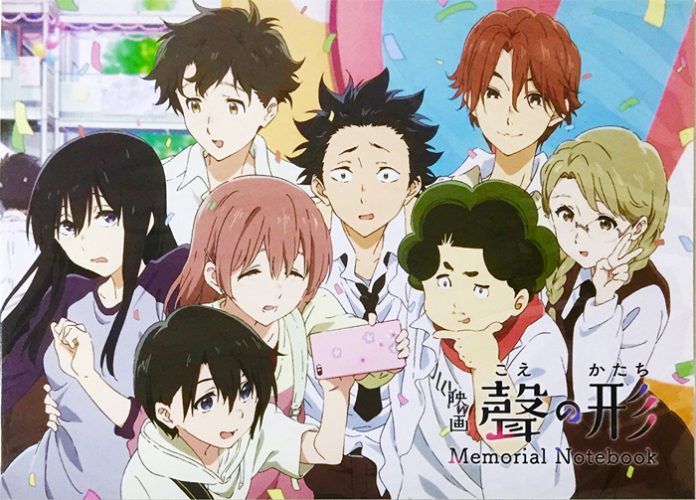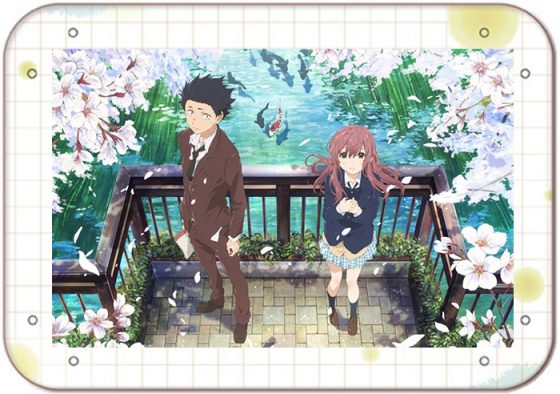
Contrary to its name, A Silent Voice (Koe no Katachi) is one of the “loudest” films I’ve experienced. Filled with verbal, nonverbal, flower, and film language, this film communicates in a style matching its protagonists.
A Silent Voice is mesmerizing, brimming with details in each scene. It manages to say so much indirectly. In doing so, viewers become more familiar with each character’s voice, recognizing their intentions and insecurities
In this article, I want to explain briefly about body language and sign language. Once both are understood, the next article will focus on a more interpretative reading, going into Naoko Yamada’s mastery of flower and film language.
Character Background and Context: Two Halves of One Story
Before we discuss body language and sign language, it’s important to understand the film’s main couple. By providing context, readers will better understand how the film matches their communication style.
The main heroine of the film is Shouko Nishimiya, a character who begins partially deaf before she eventually loses all hearing in one ear. Shouko lives in an apartment along with her younger sister, her grandmother, and her mother.
As the child of a single mother, the costs of broken hearing aids, hospital visits, and later a funeral, take their toll. We learn later that, in her eyes, she thinks of herself as a burden and the cause of a later breakup amongst friends.
For the most part, this information is unstated, requiring viewers to learn it visually. Thus, it is salient that when Shouko attempts suicide, it invokes a strong emotional response, not just within the viewers, but within the film’s other protagonist. Amidst the sounds of fireworks, shot in a disjointed manner, she jumps.
Fortunately, the character who best understands her is there. This character catches her before she falls, and in a strained manner, pulls her up, only to slip into the water below. This character is the other half to our story, Shouya Ishida.
At the beginning of the film, Shouya is seen walking to a bridge, his mind preoccupied. As we near the bridge, we see why. This is where he wants to end his life. At this point, we’re unaware of Shouya’s personality, but just as with Shouko, the film wants us to understand and empathize with him.
He decides against jumping, the sounds of fireworks and kids playing bring him back. As if on cue, the director transitions into Shouya’s own childhood. From his past, we learn he was Shouko’s bully. After Shouko leaves from the harassment, his actions eventually come full circle.
In a crucial scene, a school staff member confronts the class about Shouko’s bullying. Shouya is given a chance to confess, but just as he’s about to raise his hand, he is outed by the teacher as the sole perpetrator. In a panic, he tells on his friends, but his outburst is taken as a lie.
After this scene, he experiences the same harassment as Shouko, and from his past, we start to see his present-day self. He fears connection; his childhood is muddied by both guilt and trauma. He isolates himself, believing everyone to truly dislike him. Even without jumping, he’s falling. When he meets Shouko again, he finds the courage to reconnect, starting a new chapter in his life.
A Brief Understanding of Sign Language
A Silent Voice, both as a manga and film, has a faithful presentation of Japanese Sign Language. For those unaware, sign language is not universal with words differing from country to country. However, despite these differences, it is common for words to have a logical inference. For example, to say “I” or “me,” simply pointing your index finger at yourself suffices.
In JSL, patting your chest twice with an open hand means, “I understand.” To say something is beautiful, you place your palm facing up, and then rub its surface with your right—as if you’re cleaning a surface and it’s shining.
To say “friend,” a sign that gets gestured in the past by Shouko and in the present by Shouya, you clasp both of your palms together, your left thumb over your right index finger and your right thumb over the base of the left thumb—as if two friends are holding hands together.
These words and many others get taught throughout the film, sometimes directly as is the case with the word for “sister.” Even without knowledge of Japanese Sign Language, the movie gives context through its shots and spoken dialogue.
Through repeated exposure, audiences can eventually infer the words that are being signed. Even with silence, words are being said. People are being heard.
An Introduction into Body Language and Nonverbal Communication
Not all audiences will understand sign language—certainly, I didn’t before I studied—however, there is a “shared language” through which people can communicate. In the study of Communication, non-verbal communication is how people express themselves without words.
Some examples include distance (physically from another person), facial expressions, eye contact, tone of voice, and so forth. For clarity, sign language is verbal communication because it uses words.
Body language is under the category of nonverbal communication, and it’s a language that can transcend borders. When Shouya avoids eye contact, stares down when speaking with others, slumps his shoulders, or shows hesitation through his hands, the audience understands what’s being said, even if he doesn’t.
Shouya has very low self-esteem, his actions speaking louder than he realizes. Throughout the film, body language is used in place of spoken words. After Shouko confesses her love to Shouya, he misunderstands. She rushes home and promptly jumps onto her bed, face buried into a pillow.
Confused, her sister asks, “Did something happen?” to which Shouko responds in text, “I told Ishida that I like him.” With an incredulous outburst, her sister responds, “Are you kidding me?” The conversation is done as a shot-reverse shot, meaning every time a character responds, you see their “expression.” In the case of the sister, you see her face. In the case of Shouko, you only see her legs—logically her face is covered by the pillow.
Shouko responds with her legs flapping up and down, then a response with text, “But he didn’t understand me.” The next shot is of her legs on the bed, but no longer moving. Her energy is drained from her. Even without words, the audience can understand how much this bothered her.
Following this scene, the movie follows up on that thought—being misunderstood. After reconnecting with old classmates, Shouya loses their friendship at the bridge. The scene from his childhood is mirrored once again.
Final Thoughts

With no exaggeration, A Silent Voice is one of the key reasons I studied cinematography. I was so touched by its message that I eventually learned and practiced bits of sign language.
In the next article, I will go into detail about the flower and film language in A Silent Voice. Hopefully, at the end of this article series, you will come away with a greater appreciation for the film.
Recommended Post


